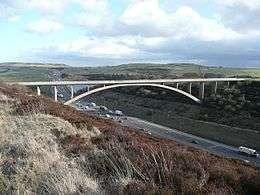Scammonden Bridge
| Scammonden Bridge | |
|---|---|
|
View east towards the reservoir | |
| Coordinates | 53°38′52″N 1°55′52″W / 53.6477°N 1.9310°WCoordinates: 53°38′52″N 1°55′52″W / 53.6477°N 1.9310°W |
| Carries | Vehicles on the B6114 |
| Crosses | M62 |
| Locale | Kirklees |
| Maintained by | Highways Agency |
| Characteristics | |
| Design | Open spandrel fixed-arch |
| Material | Reinforced concrete |
| Total length | 656 ft (200 m) |
| Width | 24 ft (7.3 m) |
| Height | 120 ft (37 m) |
| Longest span | 410 ft (120 m) |
| No. of spans | 1 |
| History | |
| Designer | Colonel Stuart Maynard Lovell |
| Constructed by | Sir Alfred McAlpine |
| Construction start | 1967 |
| Inaugurated | 14 October 1971 |
| Opened | 10 December 1970 |
Scammonden Bridge spans the Deanhead cutting carrying the B6114 (the former A6025) Elland to Buckstones road over the M62 motorway in Kirklees, West Yorkshire, England. The bridge and Scammonden Reservoir to the west are named after Scammonden, the village that was flooded to accommodate the reservoir whose dam carries the motorway. On opening, the bridge was the longest single-span non-suspension bridge in the world.[1] and it is the longest concrete arch bridge in the UK.
History
The bridge was built for the West Riding County Council to the designs of the county surveyor, Colonel S. Maynard Lovell. In March 1962 a model of the 37-mile (60 km) section of the M62 was displayed in Wakefield, the administrative centre of the West Riding County Council. The route of the motorway, from the A572 to the A640 at Huddersfield, was announced by Tom Fraser on 29 October 1964.
Design
The bridge was planned as a flat arch bridge, but aerodynamic considerations led to an open spandrel design.[2] The main span supports eight spandrel columns and there are four other columns over the motorway cutting. The spandrel columns are 18 inches (46 cm) thick.[3]
The arch is a twin box section. Its deck is an inverted T-type pretensioned prestressed concrete beam. The bridge deck is 24 feet (7.3 m) wide. Using computers, its design was calculated to withstand 110 mph (180 km/h; 49 m/s) winds, and was tested in wind tunnels at the University of Nottingham and the National Physical Laboratory.[4] The motorway cutting was profiled with 15-foot (4.6 m) 'steps'.
The road it carries was the A6025 but is now the B6114 between Elland and the A640 junction at Buckstones Moss. To the west of the bridge the M62 enters Calderdale from Kirklees; the boundary crosses the B6114 north of the bridge, and follows the north side of the M62 along Scammonden Water. The road crosses the M62 at around 1,017 feet (310 m) above sea level, northeast of Cow Gate Hill.
Construction

The arch is made of modular precast concrete sections, weighing 9,000 tonnes (8,900 long tons). The construction contractor was Alfred McAlpine. Construction of the arch required 70 miles (110 km) of scaffolding tubing. During the winter there was severe ice build up on the scaffolding.
Excavation of the Deanhead cutting was done using explosives. The cutting is 150 feet (46 m) deep, 2,600 feet (790 m) long, and 4.6 million cubic yards (3,500,000 m3) of earth was removed during its construction. Most of it was used to build the 249-foot (76 m) high Scammonden Dam across the Black Brook valley, which was the first motorway-dam project in the world. The route of the carriageway was set out in July 1963 and the motorway cutting began work in August 1964.[5] Work on the six-mile Windy Hill to Pole Moor section began on 1 November 1966 and was carried out for 12 hours on weekdays and eight hours at weekends.
See also
- List of bridges in the United Kingdom
- List of longest arch bridge spans
- List of longest masonry arch bridge spans
References
- ↑ "Scammonden Water". Scammonden Activity Centre. Retrieved 20 April 2013.
- ↑ The Motorway Archive - M62, Scammonden Bridge
- ↑ University of Bath April 2009
- ↑ Design Journal April 1971
- ↑ Engineering timetables
External links
| Wikimedia Commons has media related to Scammonden Bridge. |
Video clips
- Construction
- Sunset timelapse from the bridge
- View from the east along the M62
- View from the west
- View from the top
